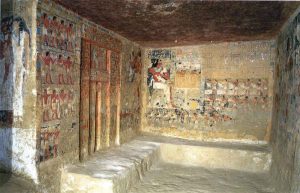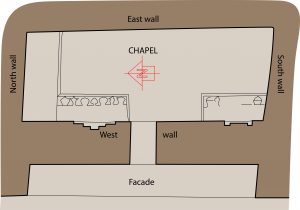Merefnebef started his career as a modest courtier who assisted the king with his morning toilette, but later in his life he was appointed a vizier – the first dignitary of the pharaonic state. According to the ancient Egyptian tradition, a dignitary should have built his own tomb during his lifetime; thus, when Merefnebef became the vizier, his house of eternity – appropriate for a modest courtier – was almost completed. It was, however, too modest for a person of his newly acquired status and position. The tomb had been therefore expanded and appropriately decorated. The tomb combines the rock-hewn, beautifully decorated chapel with an impressive mastaba built above it, its walls intersected with vertical recesses that bring to one’s mind the enclosure wall of the Step Pyramid complex towering above the cemetery. Time and nature did not spare the mud brick mastaba; only scanty remains of its walls are preserved, but as a result of the mission’s work and studies, the original appearance of the vizier’s tomb has been reconstructed.
The vizier’s body was placed in a great stone sarcophagus and deposited in the burial chamber accessible through a vertical fourteen-metre deep shaft. The anthropological examination of his skeletonized remains concluded that the vizier died when he was c. 40-50 years old.

Stoły ofiarne wzdłuż ścian kaplicy
Following the vizier’s death, his relatives and appointed funerary priests were expected to visit his tomb to bring offerings for his spirit. In case they were not able (or willing) to provide the venerable ancestor with all goods he needed (these were to be placed on offering tables along the chapel’s walls), the walls of his funerary chapel were decorated with scenes and inscriptions that – according to the ancient Egyptian beliefs – guaranteed the necessary provisions to sustain Merefnebef in the afterlife.
The funerary chapel of Merefnebef has a single, very narrow entrance in the middle of its western side; for safety reasons, the replica of the chapel cannot be entered through the original doorway, and two additional entrances have to be created in the north-western and south-eastern corners. Also, the offering tables could not be constructed. Despite these little inconveniences, we are still able to fully appreciate the richness of colours and details created by ancient artist over four millennia ago.

The decoration of the chapel consists of scenes showing the vizier, his family and servants during official ceremonies and rituals, but also enjoying various entertainments. The ancient Egyptian art was governed by some peculiar rules, thus not all scenes are easily comprehensible to a modern eye. Short descriptions of the reliefs are provided to aid the viewer with their interpretation:
